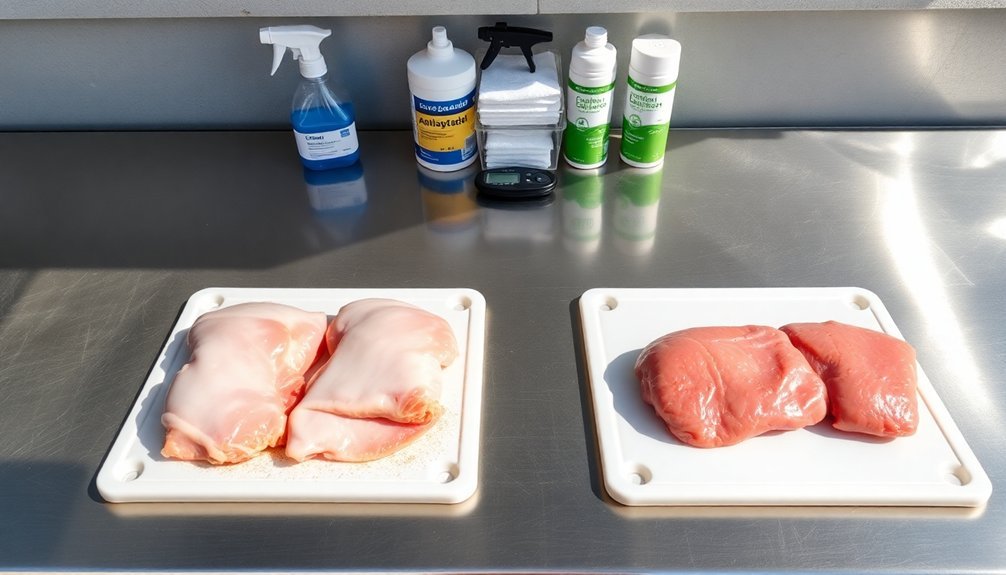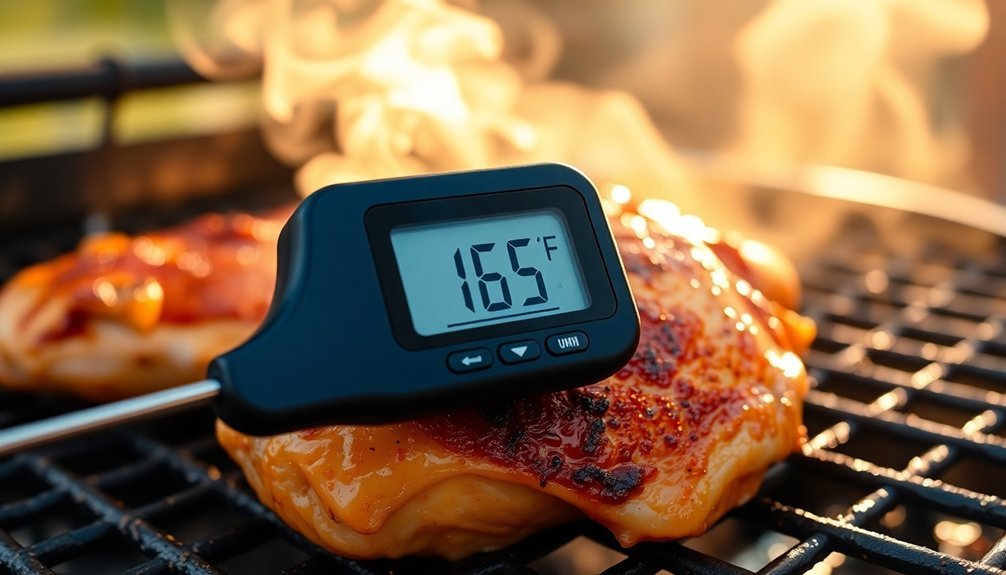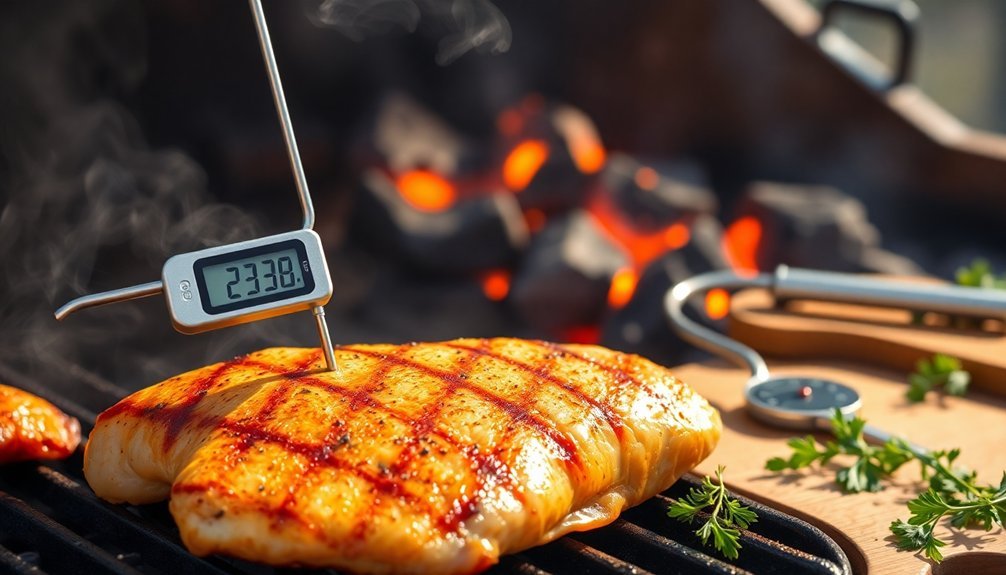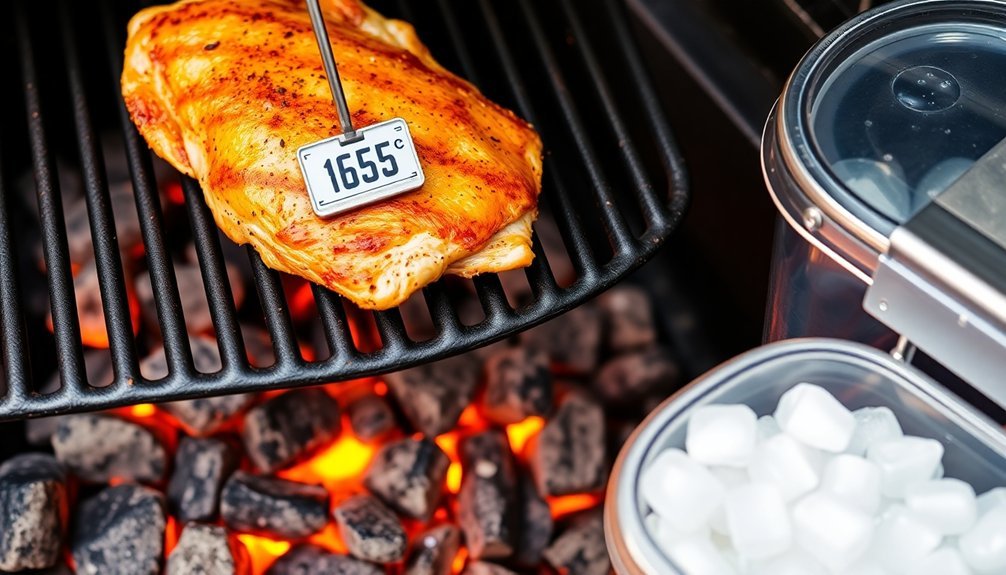Start with a clean cooking station by scrubbing your grill grates and sanitizing all surfaces. Keep raw poultry separate from other foods using dedicated cutting boards and utensils. Don't rinse raw chicken, as this spreads bacteria. Marinate in the refrigerator using sealed containers, and never reuse marinade without boiling it first. Use a meat thermometer to guarantee chicken reaches 165°F in its thickest part. Create separate hot and cold zones on your grill to prevent cross-contamination. Serve hot food above 140°F and refrigerate leftovers within two hours. Keep equipment sanitized throughout the cooking process. These fundamental safety practices are just the beginning of mastering outdoor poultry preparation.
Clean Your Cooking Station First

Before firing up the grill for outdoor poultry cooking, you'll need to properly sanitize your cooking station to prevent foodborne illness.
Start by removing any debris and gross contamination through dry cleaning methods like brushing or scraping. Pay special attention to hard-to-reach areas and dismantle removable parts for thorough cleaning.
Next, wash all surfaces with hot, soapy water (140°F), focusing on areas that might contact raw poultry. Use a high-pressure washer if available, and don't forget to clean utensils, cutting boards, and equipment. Working from top to bottom will help prevent recontamination of already cleaned areas.
After washing, rinse thoroughly and apply an EPA-registered sanitizer, ensuring it stays wet for the recommended contact time. Let everything dry completely before use.
Remember to wash your hands for 20 seconds with soap and warm water after handling raw poultry.
Prevent Raw Poultry Cross-Contamination
To guarantee food safety when cooking poultry outdoors, preventing cross-contamination must be your top priority.
Keep raw poultry separate from other foods by using dedicated cutting boards, plates, and utensils. Don't let raw chicken juices drip onto other items – place it in a plastic bag during transport and storage.
You'll need to handle raw poultry as if it's contaminated with harmful bacteria like Salmonella and Campylobacter. Wash your hands, utensils, and surfaces with hot, soapy water before and after touching raw chicken.
Don't rinse the poultry under running water, as this spreads bacteria. When you're grilling, use clean utensils and plates for cooked meat – never reuse items that touched raw chicken.
If you're using marinade, either set some aside before adding raw poultry or boil it first before using it on cooked meat.
Monitor Internal Temperature Requirements

When cooking poultry outdoors, you'll need a reliable meat thermometer to confirm it reaches a safe internal temperature of 165°F (74°C). Insert your thermometer into the thickest part of the meat, avoiding bones, and check multiple locations to ascertain even cooking. Don't rely on visual cues like meat color or juices, as they can be misleading. Using a food thermometer device is the best way to ensure proper doneness.
| Location | Required Temperature |
|---|---|
| Chicken Breast | 165°F (74°C) |
| Chicken Thigh | 165°F (74°C) |
| Stuffed Chicken | 180°F (82°C) |
While grilling, temperatures can vary greatly across your cooking surface. You'll want to monitor your chicken carefully and move pieces around as needed. Remember that proper temperature control isn't just about taste—it's essential for killing harmful bacteria like Salmonella and Campylobacter that can cause serious illness.
Safe Marinating Practices
Since marinating adds flavor and tenderness to your poultry, it's imperative to follow proper safety practices throughout the process.
Always marinate your chicken in the refrigerator on the bottom shelf, never at room temperature, to prevent bacterial growth and cross-contamination with other foods.
Use glass or plastic containers, or resealable bags for marinating, as metal containers can react with acidic ingredients.
You'll want to marinate chicken between 2 to 24 hours, depending on the size and cut.
If you're planning to use the marinade for basting, set aside a portion before adding raw meat.
Any marinade that's touched raw poultry must be boiled for one minute before using it as a sauce.
Remember to cover your marinating container with plastic wrap to prevent leaks and turn the meat occasionally for even coating.
Grilling Poultry Without Contamination

Before you start grilling, make certain all your cooking utensils, plates, and surfaces are thoroughly cleaned with hot, soapy water.
You'll need two separate sets of tongs and plates – one for raw poultry and another for cooked meat – to prevent cross-contamination.
Keep your raw chicken isolated from other foods, using designated cutting boards and storage containers throughout the entire preparation process.
Clean Tools Before Starting
Proper cleaning of your grilling tools and equipment stands as the first line of defense against foodborne illness. Start by thoroughly scrubbing your grill grates with a wire brush to remove any charred debris and residual food particles.
Don't forget to follow your grill's manufacturer guidelines for cleaning.
Before handling poultry, wash all utensils, cutting boards, and work surfaces with hot, soapy water. You'll need separate cutting boards for raw poultry and fresh produce to prevent cross-contamination.
For added safety, sanitize your cutting boards using a solution of 1 teaspoon bleach per quart of water.
Keep two sets of tongs and spatulas handy – one for raw poultry and another for cooked food.
Remember to wash your hands with soap and warm water for at least 20 seconds before and after handling raw poultry.
Keep Raw Meat Separate
Having clean tools sets the stage for the next important safety practice: keeping raw poultry completely separate from other foods.
When you're grilling outdoors, it's essential to prevent raw chicken from touching other ingredients or cooked foods.
Don't place raw poultry in the same containers or areas as your vegetables and side dishes. You'll need separate plates – one for bringing the raw chicken to the grill and another for the cooked meat.
Keep your raw poultry covered and protected from insects while you're preparing to grill. If you're using marinades, store them in the refrigerator and boil any portions you plan to reuse on cooked chicken.
Remember to use distinct utensils for handling raw and cooked meat to avoid cross-contamination that could lead to foodborne illness.
Maintaining Proper Heat Levels
You'll need to master your grill's temperature zones to safely cook poultry, creating distinct hot areas for searing and cooler sections for thorough cooking.
Using both a grill thermometer and meat probe lets you accurately monitor heat levels and guarantee your poultry reaches the critical 165°F internal temperature.
Keep a close eye on both the grill's heat and any cold spots that might develop, adjusting your fire or moving items as needed to maintain consistent cooking temperatures.
Temperature Zones Matter Most
When cooking poultry outdoors, maintaining precise temperature zones stands as the most critical factor for both safety and flavor.
You'll need to verify all poultry reaches 165°F (74°C), regardless of the cut or preparation method.
For whole birds, insert your thermometer into the thickest part of both breast and thigh, avoiding bones and fat. You'll want to check multiple spots to confirm even cooking throughout.
When preparing breasts or roasts, focus on the thickest section for your temperature reading.
Don't forget that ground poultry and stuffing require the same careful attention – they must also reach 165°F.
While thighs can safely go up to 175°F, never serve any poultry below the minimum safe temperature.
Use a reliable food thermometer to guarantee your outdoor-cooked poultry is both delicious and safe.
Monitor Heat With Tools
Modern wireless thermometers make outdoor poultry cooking both safer and more precise. You'll get accurate temperature readings within seconds, and multiple probes let you monitor both your bird's internal temperature and the grill's ambient heat simultaneously.
Today's wireless thermometers offer impressive range capabilities – up to 300 feet outdoors – so you can mingle with guests while staying connected to your cooking progress. You'll receive instant alerts on your smartphone if temperatures drift outside your set parameters or if you move out of range.
Most probes are built tough, with heat resistance up to 500°F and sturdy, sheathed wiring that won't kink or break. Look for models with bright LED displays or backlit screens, which are especially helpful when grilling in low light conditions.
Managing Hot And Cold
Three key principles govern successful outdoor poultry cooking: maintaining consistent temperature, preventing temperature fluctuations, and ensuring safe heat zones.
You'll need to master temperature control to keep your poultry safe and delicious when cooking outdoors.
- Keep raw poultry below 40°F until you're ready to cook – use a cooler with ice if you're away from your refrigerator.
- Cook your poultry to 165°F throughout, using a reliable food thermometer to check the thickest parts.
- Don't let cooked poultry sit out for more than two hours, or one hour if it's over 90°F outside.
- Create separate hot and cold zones on your grill to prevent cross-contamination between raw and cooked meat.
Remember to marinate in the refrigerator, and if you're using the marinade later, bring it to a boil first.
Using Food Thermometers Correctly

Using a food thermometer correctly is essential for safe outdoor poultry cooking. You'll want to insert the thermometer into the thickest part of the meat, avoiding bones and fat that can give false readings. For whole chickens, make sure you're not hitting any bones with the probe.
When you're grilling outdoors, check the temperature in multiple spots since heat can vary considerably. Don't let your thermometer touch the grill surface, as this will skew your reading.
You'll also need to clean your thermometer with warm soapy water after each use to prevent cross-contamination.
For best results, use a probe thermometer for continuous monitoring during longer cooking sessions, and let your poultry rest for a few minutes after cooking to account for carryover heating.
Serving Temperature Guidelines
Once you've reached the safe internal temperature of 165°F for your poultry, you'll need to maintain hot foods at 140°F or above if serving outdoors.
You can keep cooked poultry warm using chafing dishes, slow cookers, or insulated containers specifically designed for hot holding.
If you can't maintain these temperatures, plan to serve your poultry immediately and refrigerate any leftovers within two hours (or within one hour if outdoor temperatures exceed 90°F) to prevent your food from lingering in the dangerous temperature zone between 40°F and 140°F.
Hot Holding Temperatures Required
After cooking poultry to its safe internal temperature of 165°F (74°C), you'll need to maintain hot holding temperatures between 57°C to 63°C (135°F to 145°F) when serving.
This temperature range prevents bacterial growth and guarantees your outdoor-cooked poultry remains safe to eat.
To maintain proper hot holding temperatures outdoors:
- Use a calibrated digital thermometer to regularly check the food's temperature.
- Keep poultry in insulated containers or warming trays designed for outdoor use.
- Monitor temperatures every 30 minutes and adjust heat sources as needed.
- Record temperature readings to track consistency and identify potential issues.
Don't let your poultry fall into the danger zone where bacteria can multiply.
If you're unable to maintain these temperatures consistently, it's safer to serve the food immediately after cooking rather than holding it.
Danger Zone Prevention Methods
To keep your outdoor-cooked poultry safe, you'll need to actively manage serving temperatures and prevent food from lingering in the dangerous 40°F to 140°F (4°C to 60°C) range where bacteria thrive.
Don't leave your cooked poultry out for more than two hours, and use insulated containers or warming trays to maintain proper serving temperatures.
Keep your thermometer handy to monitor temperatures throughout the serving period. When you're ready to serve, guarantee the internal temperature of your poultry remains at or above 165°F (74°C).
If you're serving buffet-style, use chafing dishes with heat sources to maintain safe temperatures. For cold poultry dishes, use ice baths or refrigerated serving trays to keep temperatures below 40°F (4°C).
Remember to use separate serving utensils for each dish to prevent cross-contamination.
Storing Leftover Poultry Safely

Proper storage of leftover poultry is essential for both food safety and quality.
You'll need to act quickly after cooking, as bacteria can multiply rapidly at room temperature. Cool your cooked poultry within two hours, or one hour if it's over 90°F outside, before transferring it to the refrigerator.
To maintain safety and freshness, follow these vital steps:
- Store poultry in airtight containers or wrap tightly in aluminum foil
- Keep your refrigerator at 40°F or below
- Label containers with the date of storage
- Place containers away from raw meats to prevent cross-contamination
Keeping Equipment Sanitized
Maintaining sanitized equipment while cooking poultry outdoors is essential for preventing foodborne illness. Before you begin, inspect all your tools and make certain they're clean. Use hot, soapy water to scrub any surfaces or utensils that will touch raw poultry.
You'll need to sanitize equipment after cleaning it. Mix an EPA-approved sanitizer, like chlorine, to the correct concentration (50-200 ppm), and use a test kit to verify the strength.
Don't forget to use separate cutting boards for raw poultry and other foods. When handling raw poultry, always wear disposable gloves and wash your hands thoroughly between tasks.
Clean and sanitize your equipment at least every four hours during use, and immediately address any visible soiling. This practice helps guarantee your outdoor cooking stays safe and enjoyable.
Frequently Asked Questions
How Long Should Wood Chips Soak Before Adding Them to the Smoker?
You don't need to soak wood chips before smoking – it's actually counterproductive. If you still want to soak them, 30-60 minutes is enough since water won't penetrate deeper even with longer soaking.
Can I Use Different Types of Wood Chips Together for Smoking Poultry?
Yes, you can definitely mix wood chips! Combining different woods creates complex flavor profiles. Try pairing strong woods like hickory with milder ones like apple or cherry for a balanced, delicious taste in your poultry.
What Should I Do if It Starts Raining While Grilling Poultry?
If it starts raining, move your grill under a covered area or use a heat-resistant umbrella. Keep cooking at high heat to maintain temperature, and don't use electric grills. Monitor poultry's internal temperature closely.
How Often Should I Clean or Replace My Grill's Drip Pans?
Clean your drip pan after each use if you grill frequently, or every few sessions for occasional grilling. You'll need to replace it if it shows rust. Line it with foil for easier cleanup.
Should I Oil the Grill Grates Before Cooking Poultry?
You don't need to oil the grates specifically for poultry. Instead, oil your meat directly – it'll prevent sticking, distribute flavor better, and create those perfect grill marks while avoiding potential flare-ups.
In Summary
You've learned essential tips for safely preparing poultry outdoors. Remember, you're only as safe as your cleanest cooking practice. Always maintain proper temperatures, avoid cross-contamination, and keep your equipment sanitized. When you're grilling poultry, there's no room for guesswork – use your food thermometer and follow safe storage guidelines. These habits will keep your outdoor cooking both delicious and safe.





Leave a Reply